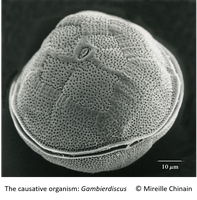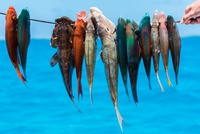Ciguatera fish poisoning
Andreas Seger, 10 Dec 2020.
Ciguatera fish poisoning is a human illness cause by eating tropical and subtropical fish that are contaminated with ciguatoxins, which are produced by tiny microalgae of the genus Gambierdiscus. Changes in weather patterns, environmental conditions and range extension of marine species have the potential to cause ciguatera fish poisoning to appear in new areas. National and international research is currently underway to better understand the issue.
What is ciguatera fish poisoning?
Ciguatera fish poisoning occurs when humans ingest fish, or more rarely shellfish, contaminated with ciguatoxins. The severity of symptoms differs widely between individuals and some might only experience diarrhoea, vomiting and strange tingling sensations. While those are unpleasant enough, others suffer neurological symptoms that in rare cases can last several years. This includes the tell-tale reversal of hot-cold sensations: ice cubes will feel like they are melting through your palm and fire will feel like ice. There are stories of ciguatera sufferers having to request their partners to check the shower temperature for them every morning in case they burn themselves. Other people describe a strange sensation of accidentally stepping into a hole in the ground, even though they are walking on a completely flat surface. There is no way to cure ciguatera, but a doctor may be able to treat the symptoms. After recovering, avoid a relapse by avoiding fish, nuts, alcohol, and caffeine for at least 6 months.
How do the ciguatoxins end up in the fish?
It all starts with a tiny microalga of the genus Gambierdiscus (see photo) and the toxin precursors produced by it. This microscopic alga grows attached to coral or seagrass, where herbivorous (plant-eating) fish graze and convert the toxin precursors to the ciguatoxins that can poison humans when present in sufficient quantities. Predatory fish feeding on these species can then further accumulate the toxins. It is important to note that contrary to common belief, smaller herbivorous fish can also rapidly take up the toxins in quantities sufficient to cause human illness if consumed.
How do we detect the ciguatoxins?
Ciguatoxins are notoriously hard to detect. This is largely due to the extremely low concentrations that we are trying to measure: as little as 1 part per billion could cause the onset of symptoms. To give you a better idea of how little that is: if you were to roll out a single layer of toilet paper from New York to London (~5500 km), one part per billion represents one single sheet in that length! Furthermore, the reference materials required to measure ciguatoxins are difficult to obtain. Grinding up 48 kg of moray eel guts only yielded less than a milligram of purified toxin! No reliable quick DIY test kit currently exits, and analysis continues to rely on complicated laboratory techniques.
Since the toxin is quite stable and not destroyed by freezing or cooking, it is always a good idea to keep some of your fish in the freezer when consuming species known to carry ciguatoxins. As little as 10-30 grams of sample are enough to test for ciguatoxin. QLD Health and the NSW Food Authority can initiate testing for ciguatoxins when requested by a general practitioner.
What is the risk of ciguatera in Australia?
Compared to other food related illnesses, such as Salmonella, the risk of ciguatera fish poisoning in Australia is currently low. As the responsible microalgae predominantly occur in tropical and sub-tropical areas, QLD and the NT are where most cases of ciguatera are reported. However, fish move across borders, whether that is due to interstate transport of wild-caught fish, part of range extensions or migratory routes. A good example is a number of ciguatera cases reported in NSW after consuming Spanish Mackerel that had migrated into NSW waters from QLD. By being aware of some of the risk factors, the risk of exposure can be reduced even further. Seeking local knowledge as to what species to avoid at what time of year and from what areas, certainly is a good start. Avoiding the viscera (guts and organs, especially the liver) and the flesh around the head are also good strategies, as ciguatoxins have been shown to accumulate to even higher concentrations in those tissues than they do in the flesh. Limiting the intake of fish to single meals and sharing the fish is another option to reduce your individual exposure to lower concentrations of ciguatoxin and avoid cumulative ciguatoxin uptake.
What is being done about it?
There is a great deal of international momentum behind ciguatera research at the moment, as changing weather patterns and environmental conditions are likely to increase the incidence of poisoning events. Scientists from around the globe are working on new techniques to detect the toxins, to understand their seasonality and impacts on the human body. This international momentum has been carried onto Australian shores, where a national ciguatera research strategy was developed through the SafeFish seafood safety program (see link below). The strategy is explicit in highlighting that awareness of ciguatera symptoms is key to improving understanding and reducing exposure.
Further reading
Here are some links for those interested in further information on ciguatera fish poisoning:
Two fact sheets on ciguatera are available from QLD Health (HERE) and NSW Health (HERE).
A recording of a short presentation summarising ciguatera in Australia is available from the Australian Recreational Fishing Foundation website HERE (video at top - starting at 29:30 min).
The SafeFish national ciguatera research strategy is available HERE.
This French Polynesian website (HERE) also gives more background on ciguatera.













